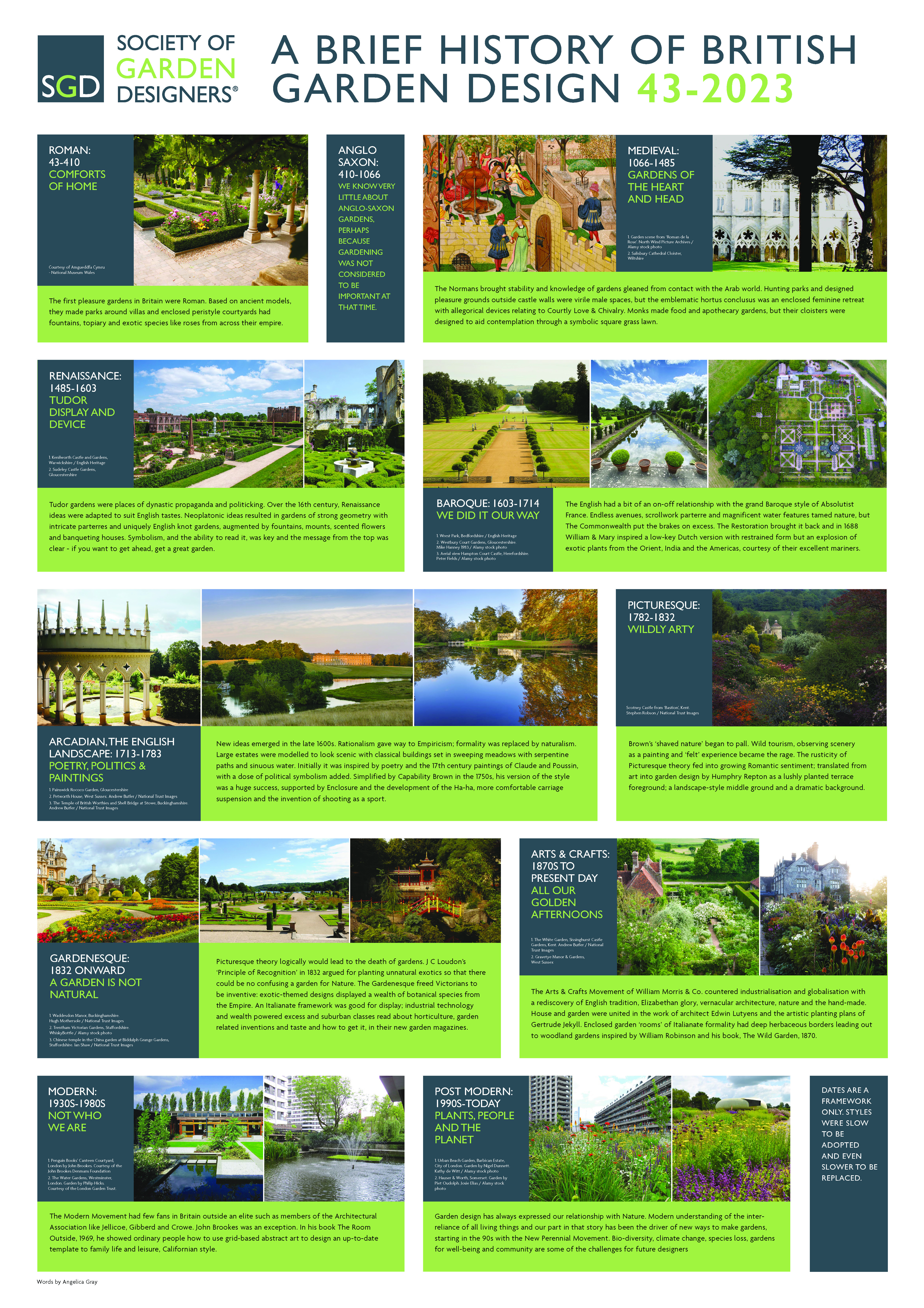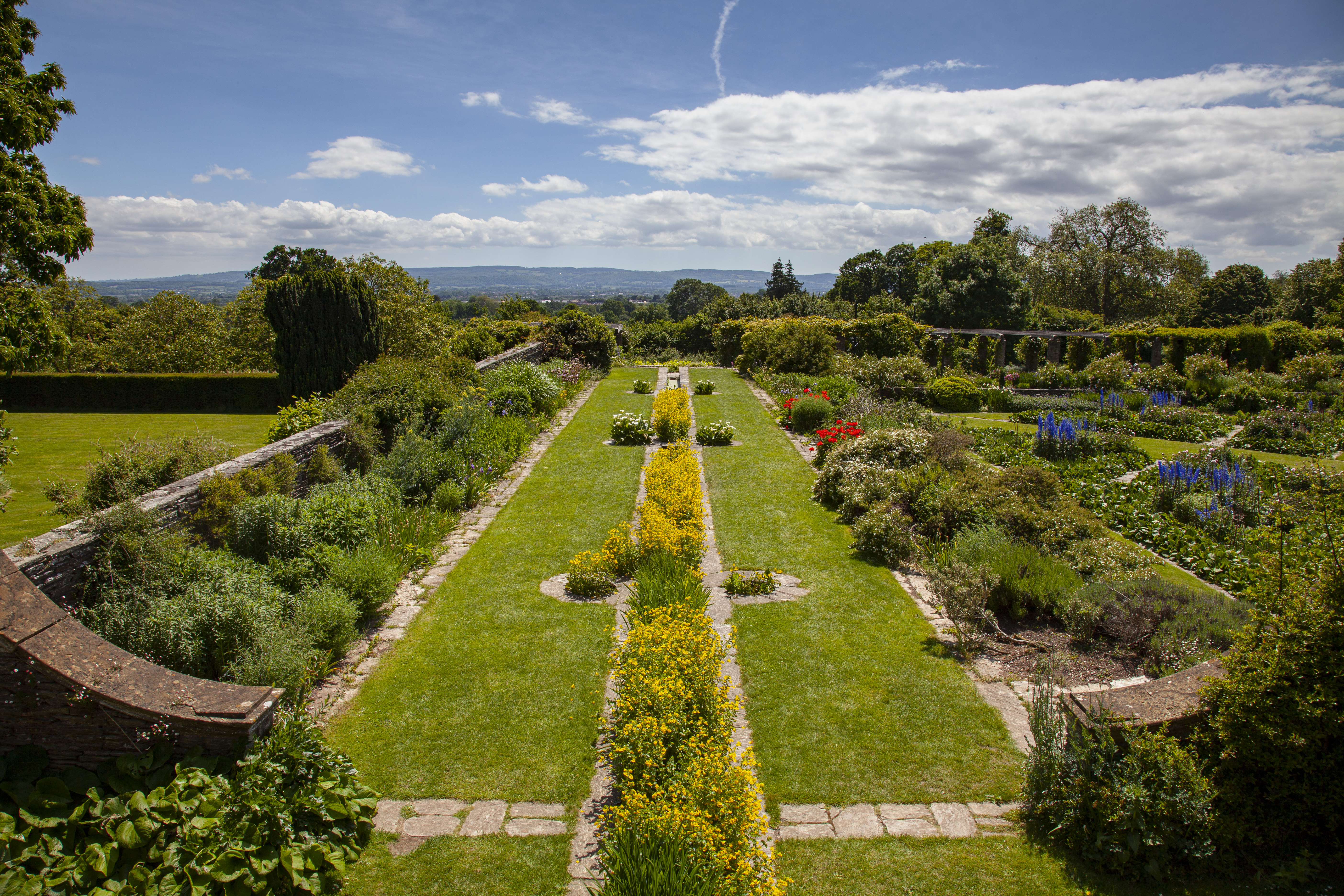- Home
- Garden History Poster
GARDEN HISTORY POSTER
A BRIEF HISTORY OF BRITISH GARDEN DESIGN 43-2023
The Society of Garden Designers is excited to launch its Garden History Poster. As designers we are aware of the importance of what came before us and more than ever understand the relevance in imbedding it in our design process. The poster gives both new and established designers the opportunity to reference the various movements in garden history quickly and most importantly visually. We hope you will have it in a prime location above your drawing board!

Everything has a history and gardens are no exception: in Britain we can trace our garden history back two thousand years, which is pretty amazing. But what is the point in contemporary designers being familiar with past styles, historic garden heroes and a trugful of dates? We want to persuade you that it is profoundly important for designers and their clients to understand that they are making history with their choices, and that those choices are a reflection of our present society. In looking at the past we are better able to understand ourselves and to dig deeper into how gardens work, not only as living spaces to be enjoyed, but as significant cultural artefacts.
The period styles outlined in the poster each have something to say about the era in which they were conceived. Gardens are slow to grow, often expensive and therefore slow to change too but they have always been subject to changes in fashion and ideas. Many now absorbed into what we view as a tradition were once daring and cutting edge designs. It is usual to experience a garden as a sensual pleasure but they also have an historical context, reflecting areas of experience as diverse as political divides, education, literature, social class, philosophy, gender politics, scientific advances, empire and power. Technological changes inspired new features which the modern visitor takes for granted. The long and winding driveways of the later English Landscape style were made in response to improvements to carriage suspension making travel more comfortable.
All design ideas are subject to the zeitgeist; even the nature of Nature itself is subject to philosophical debate. The Medieval garden was a refuge from its dangers, the Romantic garden celebrated the thrill of the wild and the Victorian garden was a showcase for man the omniscient collector. Garden design today is responding to signifiant changes in our relationship with nature and many other issues of a broadly political nature. Climate change, sustainabiity and water conservation require us to challenge an old orthodoxy; adapting to new plants, methods and ultimately a radical new aesthetic. A philosophical change to a non-anthropocentric view of the planet implies design which advocates for a species-rich garden space. Ethical questions of colonisation, native versus exotic, cultural appropriation, inclusivity, diversity and mental health to name but a few are subjects for discussion. There is a lot going on in the garden these days.
Understanding the preoccupations of past generations highlights those of our own time. Old solutions to problems, such as water conservation, can offer valuable insight and experience. It is inevitably part of the creative process to understand where we have been to better decide in which direction we are heading. Partnering with clients to arrive at a garden which is sustainable, meaningful as well as beautiful in the context of our shared garden history and future has to be a worthwhile ambition. History is memory; it is witness and knowledge – let’s celebrate the wonderful resource which is our garden history.
Click on the poster image to download.
Text by Angelica Gray.
If you are interested in learning more about the history of garden design or would like to visit some heritage gardens, you can visit Parks and Gardens UK.
 Parks & Gardens UK is the leading online resource for historic parks & gardens and provides freely accessible and inspiring information about parks, gardens and designed landscapes. The archive has over 9,500 location records and over 2,400 biographies of people and organisations, and offers a powerful research resource for visitors to access information relating to thousands of locations and garden designers, both historic and current. The archive has over 1 million page views per year and on average over 60 thousand visitors per month. This includes UK and international visitors.
Parks & Gardens UK is the leading online resource for historic parks & gardens and provides freely accessible and inspiring information about parks, gardens and designed landscapes. The archive has over 9,500 location records and over 2,400 biographies of people and organisations, and offers a powerful research resource for visitors to access information relating to thousands of locations and garden designers, both historic and current. The archive has over 1 million page views per year and on average over 60 thousand visitors per month. This includes UK and international visitors.
The Parks & Gardens archive moved to the Hestercombe Gardens Trust in 2016 and has grown from strength to strength. Improvements such as a new platform, new search map functionality, a new Conservation Management Plan searchable database and updates across the archive.
The archive also has a ‘News & Events’ page which enables Parks & Gardens to inform visitors of conferences, events, books and other information related to parks, gardens and designed landscapes across the UK and internationally.
Donations, grants and funding enable the continued development of the archive and ensure that historic information regarding parks, gardens and designed landscapes is available for future generations.